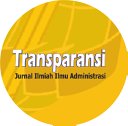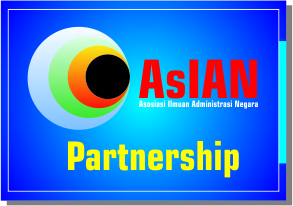Strategi Penerapan Manajemen Resiko dalam Rangka Peningkatan Kinerja Instansi Pemerintah di Kota Bekasi
DOI:
https://doi.org/10.31334/transparansi.v6i1.3194Keywords:
Implementation Strategy, Risk Management, Institutional Performance Improvement,Abstract
The Municipal Government of Bekasi has known risk management through elements of risk assessment since 2011, but until now in its implementation it has not yet had an ideal strategy so that the hope of creating good governance has not been fully achieved. As one of the strategic needs in improving organizational performance, risk management is needed in optimizing the use of resources owned by the organization through rearranging the governance system by applying the principles of transparency and accountability. This study aims to determine the factors that have caused the implementation of risk management in the Bekasi City Government to not run effectively and efficiently so that a risk management strategy design is needed that is in accordance with the characteristics of local wisdom in improving the performance of agencies in the Bekasi City Government. The method used in this study is a qualitative case study method with purposive and snowball sampling techniques. As for data collection techniques through in-depth interviews with data processing using triangulation (combined) and is inductive. The final results of this study indicate that risk management must be managed based on the regulation of the Deputy for Supervision of Regional Financial Management No. 04 of 2019 concerning guidelines for risk management in local governments. Performance accountability is the obligation of government agencies to be accountable for their performance achievements, which are set forth in a report through SAKIP. to improve government performance accountability, risks from programs and activities must be managed through good and correct risk management. The implementation of Risk Management is influenced by external factors, namely the OPD within the Bekasi City Government and internally, in this case the Regional Inspectorate Institution; in terms of human resources, budget and other facilities and infrastructure.References
The Committee of Sponsoring Organizations of the Treadway Commission (COSO). (2017). Enterprises Risk Management Integrating with Strategy and Performance.
The Institute of Risk Management (IRM). (2012). Risk Culture - Resources for Practitioners.
The International Organization for Standardization. (2018). ISO 31000:2018 Risk Management — Guidelines.
Hardy, Karen. (2009). Managing Risk in Government : An Introduction to Enterprise Risk Management. https://www.businessofgovernment.org/sites/default/files/RiskinGovernment.pdf
Bevir, Mark. (2011). The Sage Handbook of Governance. London : SAGE Publications Ltd.
Cooper, Thomas. (2010). Strategic Risk Management in The Munnicipal and Public Sector, An Exploration of Critical Success Factor and Barrier to Strategic Risk Management within The Province of Newfoundland and Lablador. The Harris Centre Memorial University.
Mardiasmo. (2009). Akuntabilitas Sektor Publik, Andi, Yogyakarta
Moeller, R. (2007). COSO Enterprise Risk Management : Understanding The New Integrated Erm Framework. New Jersey: John Wiley & Sons Inc
Rahardjo, Mudjia. (2017). Studi kasus dalam penelitian kualitatif: konsep dan prosedurnya. Malang: Universitas Islam Negeri Maulana Malik Ibrahim.
Silalahi, Ulber. (2016). Asas-Asas Manajemen. Bandung: PT Refika Aditama
Rangkuti, Freddy. (2017). Teknik Membedah Kasus Bisnis Analisis SWOT Cara Perhitungan Bobot, Rating, dan OCAI. Jakarta: Kompas Gramedia
Sedarmayanti. (2009). Reformasi Administrasi Publik, Reformasi Birokrasi, dan Kepemimpinan Masa Depan (Mewujudkan Pelayanan Prima dan Kepemerintahan yang Baik). Bandung: PT Refika Aditama.
Ghony, M. Djunaidi & Almansur, Fauzan. (2012). Metodologi Penelitian Kualitatif. Jogjakarta: Ar-ruzz Media.
Osborne, David dan Ted Gaebler. (1992). Reinventing Government: How the Entrepreneurial Spirit is Transforming the Public Sector, diterjemahkan oleh Abdul Rosyid. 1996. Mewirausahakan Birokrasi: Mentransformasikan Semangat Wirausaha ke dalam Sektor Publik. Jakarta: Pustaka Binaman Pressido.
Osborne, David dan Peter Plastrik. (1997). Banishing Bureaucracy: The Five Strategies for Reinventing Government. Diterjemahkan oleh Abdul Rosyid dan Ramelan. 2001. Memangkas Birokrasi: Lima Strategi Menuju Pemerintahan Wirausaha. Jakarta: Penerbit PPM.
Robbins, S dan Coulter, M. (2007). Manajemen. Edisi Kedelapan. Jakarta: Penerbit PT Indeks.
Robert W. Bradford, Peter Duncan, dan Brian Tarcy. (2007). Simplified Strategic Planning: A Nonsense Guide for Busy People Who Want Result Fast. New York: McGraw Hill.
Susilo, Leo J., & Kaho, Victor Riwu Kaho. (2018). Manajemen Risiko Panduan untuk Risk Leaders dan Risk Practitioners. Jakarta: Grasindo.
Suwanda, D., Junjunan, B. A., A, A., & R, E. Manajemen Risiko Pengelolaan Keuangan Daerah sebagai Upaya Peningkatan Transparansi dan Akuntabilitas Publik. Bandung: PT Remaja Rosdakarya.
Blanchard, Danielle & Dionne, Georges. (2003). Risk Management & Corporate Governance. HEC. Montreal Risk Management Chair Working Paper No. 03-04. https://papers.ssrn.com/sol3
Cahyadi Hendra. (2015). Evaluasi Implementasi Kebijakan Manajemen Risiko dalam Rangka manajemen Kinerja di Kementrian Keuangan. Jakarta: Inspektorat Jenderal Kementrian Keuangan. http://jurnal.pknstan.ac.id/index.php/JIA/article/view/110
Downloads
Published
Issue
Section
License

This work is licensed under a Creative Commons Attribution-ShareAlike 4.0 International License
Please find the rights and licenses in Transparansi : Jurnal Ilmiah Ilmu Administrasi By submitting the article/manuscript of the article, the author(s) agree with this policy. No specific document sign-off is required.
- License
The commercial use of the article will be governed by the Creative Commons Attribution license as currently displayed on Creative Commons Attribution-ShareAlike 4.0 International License.
2. Author(s)' Warranties
The author warrants that the article is original, written by stated author(s), has not been published before, contains no unlawful statements, does not infringe the rights of others, is subject to copyright that is vested exclusively in the author and free of any third party rights, and that any necessary written permissions to quote from other sources have been obtained by the author(s).
3. User Rights
Transparansi : Jurnal Ilmiah Ilmu Administrasi spirit is to disseminate articles published are as free as possible. Under the Creative Commons license, Transparansi : Jurnal Ilmiah Ilmu Administrasi permits users to copy, distribute, display, and perform the work for non-commercial purposes only. Users will also need to attribute authors and Transparansi : Jurnal Ilmiah Ilmu Administrasi on distributing works in the journal and other media of publications.
4. Co-Authorship
If the article was jointly prepared by more than one author, any authors submitting the manuscript warrants that he/she has been authorized by all co-authors to be agreed on this copyright and license notice (agreement) on their behalf, and agrees to inform his/her co-authors of the terms of this policy. Transparansi : Jurnal Ilmiah Ilmu Administrasi will not be held liable for anything that may arise due to the author(s) internal dispute. Transparansi : Jurnal Ilmiah Ilmu Administrasi will only communicate with the corresponding author.
5. Miscellaneous
Transparansi : Jurnal Ilmiah Ilmu Administrasi will publish the article (or have it published) in the journal if the article’s editorial process is successfully completed. Transparansi : Jurnal Ilmiah Ilmu Administrasi editors may modify the article to a style of punctuation, spelling, capitalization, referencing and usage that deems appropriate. The author acknowledges that the article may be published so that it will be publicly accessible and such access will be free of charge for the readers as mentioned in point 3.
Every accepted manuscript should be accompanied by "Copyright Transfer Agreement"prior to the article publication.











